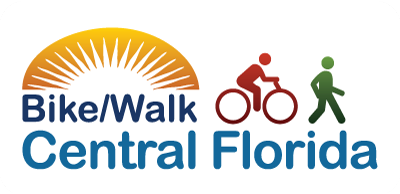Posted on Aug. 13, 2015 in Places, WPHF News
 Cady Way, the street which fronts Brookshire Elementary school in Winter Park, was outfitted with a cycle track in time for the start of the 2015-16 school year. The new cycle track, a special bike lane featuring a physical barrier (such as a curb or plastic post) between cars and cyclists, was made possible through a grant from the Winter Park Health Foundation along with funding from the City of Winter Park.
Cady Way, the street which fronts Brookshire Elementary school in Winter Park, was outfitted with a cycle track in time for the start of the 2015-16 school year. The new cycle track, a special bike lane featuring a physical barrier (such as a curb or plastic post) between cars and cyclists, was made possible through a grant from the Winter Park Health Foundation along with funding from the City of Winter Park.
Parents and cycling enthusiasts advocated for the cycle track as a solution to a variety of issues including the need to develop a safe route to school for elementary school age children who live in this area of Winter Park. The protected bike lane will provide a safer, more comfortable route to school for children biking to and from Brookshire Elementary as well as cyclists of all ages pedaling to area parks and recreational facilities including the Cady Way Swimming Pool, Showalter Field, and the Cady Way Trail.
“Parents did not feel comfortable allowing their children to bike in the street near Brookshire Elementary School’, said Rick Geller, parent of three students at the school. A thin line painted in the street for a conventional bike lane does not give a sufficient sense of protection.”
New York City has installed more than 20 miles of protected bike lanes and, on each street the number of injury crashes for all users has declined between 28-62%, according to Amanda Day, Director of Bike Walk Central Florida. One study found protected bike lanes reduce injuries by as much as 90%. Protected bike lanes are now installed in more than two dozen cities across the United States, but the Cady Way cycle track is a first for Central Florida.
Cities across the country with protected bike lanes are finding these improvements promote exercise and economic development while offering a clean alternative mode of transportation. A recent study published in the American Journal of Public Health found that compared to roads without any biking infrastructure, the risk of injury for riders on protected lanes dropped by 90 percent while roadside bike lanes saw a drop of just 50 percent. Since safer bike lanes are used more often (all things equal), it could be argued that they would be a greater source of public health. A 2008 study in the Journal of Physical Activity and Health found a strong inverse relationship between the occurrence of obesity and active transportation. (Source: “Protected Bike Lanes Benefit You, the Economy, and the Environment” by Chris DeArmond, March 14, 2013)

